UNIVERSITY
Tracking Brown’s history of queerness
Alums, students consider how queer visibility, experience has changed
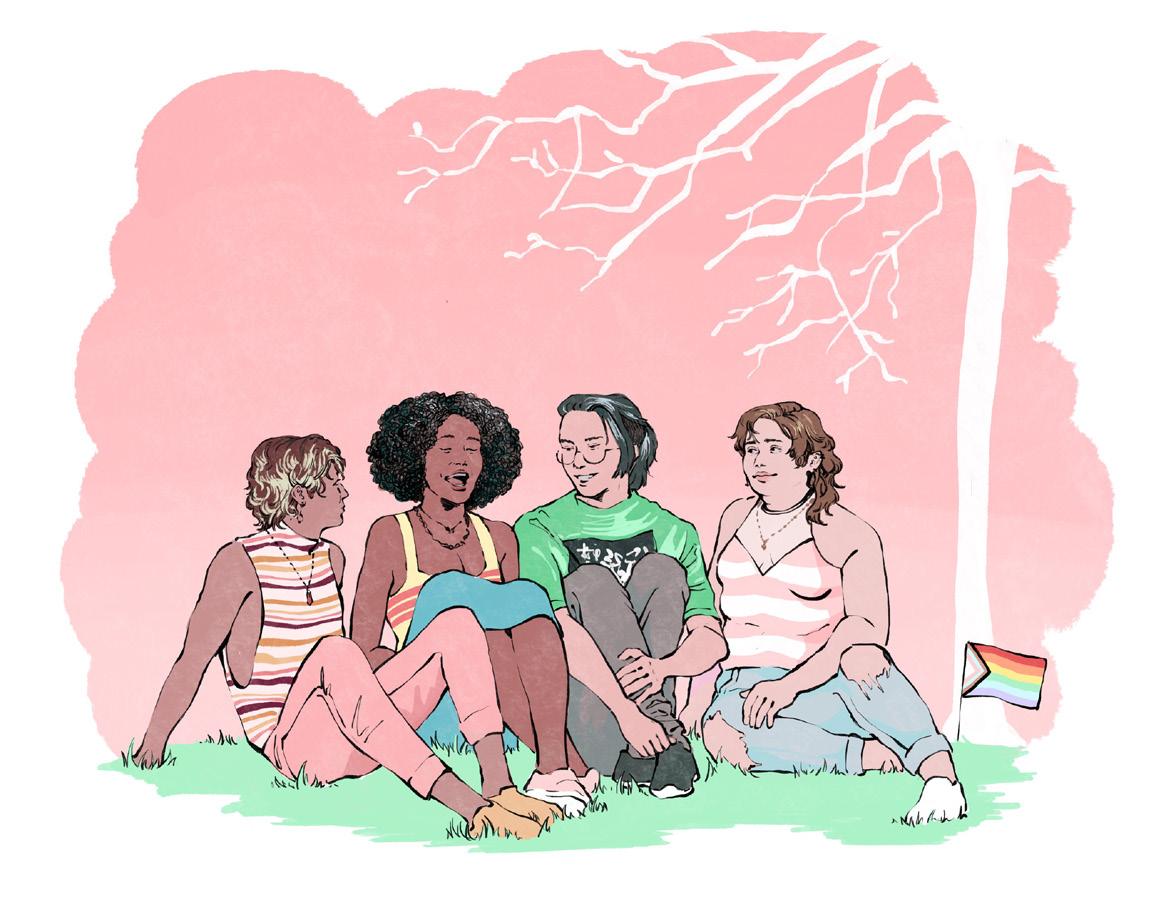

 BY LILIANA GREYF STAFF WRITER
BY LILIANA GREYF STAFF WRITER
Content warning: This article includes mentions of homophobic slurs and inci dents and descriptions of sexual assault.

“One of the great mysteries at Brown is a certain group of individuals, both male and female, who differ from the majority, the ‘normal’ student popu lation, in that they are homosexuals,” began an article published in The Herald Oct. 30, 1973. Almost half a century later, queerness is burgeoning at Brown. Over 35% of Brown’s current student body do not identify as heterosexual, according to recent reporting by The Herald. Generally, queerness is much more prevalent on-campus today than it was decades ago. Queer studies are taught in several departments, the LGBTQ Center has moved into a larger
renovated space and students flock to gay clubs. But Brown hasn’t always been as queer — or as accepting of queerness — as it is today.
1919-1968: Before the Gay Liberation movement
Before the publication of the 1973 article, which announced the “com ing-out” of the Brown University Gay Liberation club, queer issues were rarely discussed in The Herald or elsewhere
Jill Lepore talks amending Constitution, originalism
Lepore thanked the crowd for “coming out to think about the U.S. Constitution,” and pulled up a Power Point presentation that depicted her “own frustration with the brittleness of our political discourse” around the Constitution.
on campus.
UNIVERSITY NEWS
SCRAP, SLUG, West House envision how University can improve sustainability policies
BY JULIA VAZ SENIOR STAFF WRITER
In recent years, the University has an nounced a series of policies concern ing its relationship with the environ ment and addressing climate change. In 2019, the University committed to cutting campus greenhouse gas emissions to net-zero by 2040, and a year later pledged to halt investments in fossil fuel extraction. In 2021, it released a Sustainability Strategic Plan outlining the path to net-zero emissions.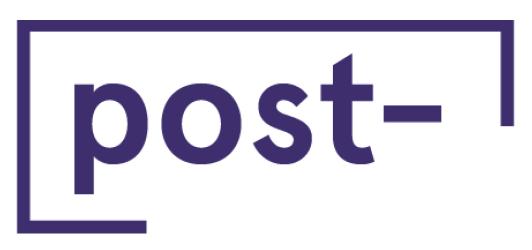
can foster sustainability.
PAGE 8As Brown moves forward with its broader climate policies, The Herald spoke to three environmentally-fo cused student groups on campus about their daily advocacy and the often-overlooked ways institutions
BY SOFIA BARNETT SENIOR STAFF WRITERHistorian and journalist Jill Lep ore joined University students and faculty Thursday for a lecture en titled “Making Amends: Revising the U.S. Constitution,” in which she explored the complexities of passing constitutional amendments, the history of constitutional inter pretation and the state of American democracy.
The lecture was a part of the Lemley Family Leadership Lecture Series, which seeks to invite “excep tional leaders who are preeminent in their field to campus to engage and inspire the University communi ty,” according to its website. Lepore was introduced by Provost Richard Locke P’18, who also moderated the question-and-answer session that concluded the event.
Lepore kicked off her presenta tion by comparing the Constitution to an oven.
“If you have an oven that has a self-cleaning button, you press the button and it gets to 9,000 degrees and it might smell bad and you might be afraid your house is going to burn down, but it’s an automatic way to clean itself,” she said. “The Consti tution is the same. It was designed as a machine, and the framers designed it with a self-cleaning button for the machine to work.”
Lepore explained that the framers’ intended “self-cleaning button” in the Constitution is the amendment process, but that amending the Con stitution is not as politically feasible as it may seem.
According to Lepore, the ability to amend the Constitution comes from
BY SOFIA BARNETT SENIOR STAFF WRITEROn Oct. 31, the U.S. Supreme Court heard arguments in two cases surround ing the constitutionality of race-con scious college admissions. In both cases, the court’s conservative majority indi cated a willingness to end affirmative action in the process.
Brought forward by anti-affirmative action group Students for Fair Admis sions, the cases surround admission policy at Harvard and the University of North Carolina, respectively.
Most recently, the Supreme Court ruled on affirmative action in higher education in Fisher v. University of Tex as at Austin. The 2016 decision allowed colleges to continue considering race in applications.
Before the Fisher case, the Supreme Court had largely ruled the practice le gal. In both its 1978 ruling in Regents of the University of California v. Bakke and its 2003 ruling in Grutter v. Bollinger, the court set the precedent that ad
missions offices could factor in race as one of many factors in an application — though it outlawed the use of quota systems in 1978.
Affirmative action is an “essential policy reform,” said Jonathan Collins, assistant professor of political science, public policy and education. At colleges, affirmative action “tries to ensure that there is diversity and, particularly, racial balance.”
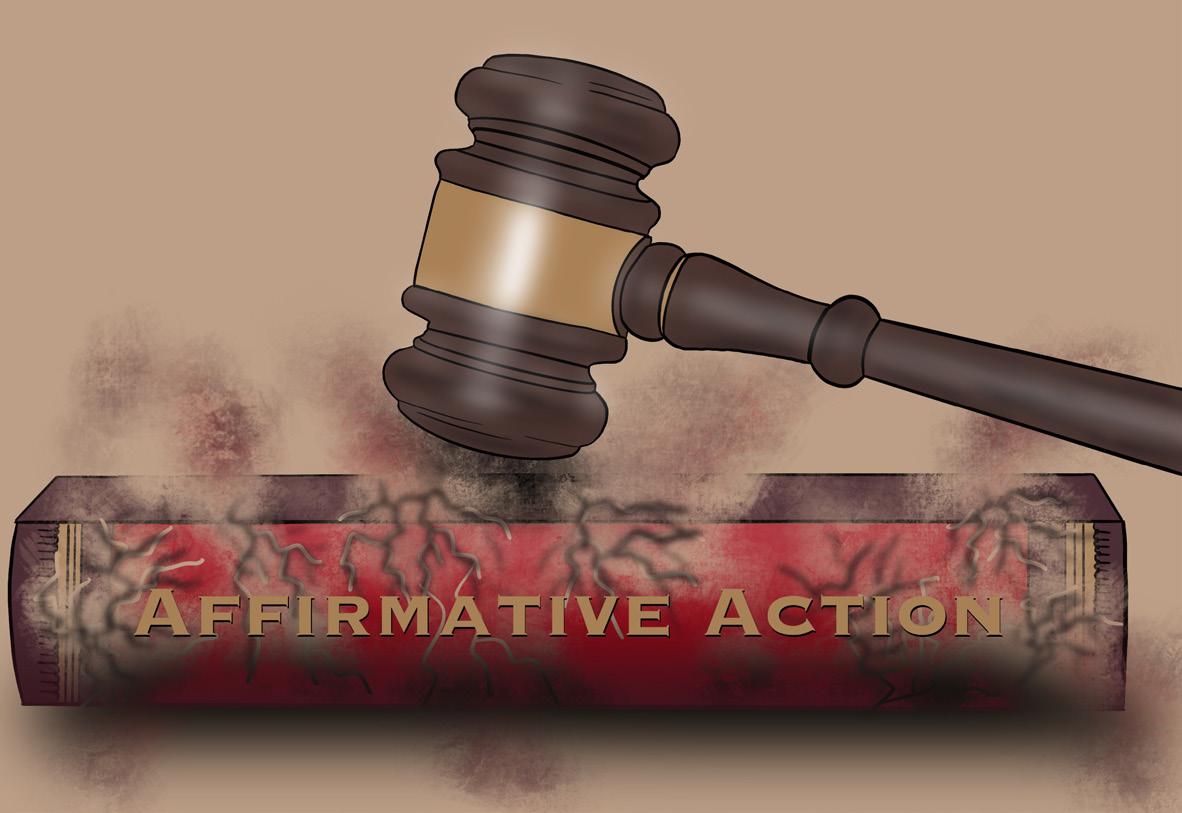
“It serves to both provide oppor tunity for socio-economic mobility for historically marginalized groups, but then to also ensure that the space … offers the unique voices of multiple
SCRAP:
Looking beyond compost ing
At the student garden outside of Perkins Hall, Abbie Macher ’23 and Jadyn Ligoo ’25 worked through the composting process. They are both members of SCRAP, Brown’s student composting group. In front of deco rated wooden bins, they explained the many stages compost must go through before it is ready for use. “It’s a months-long activity,” Ligoo said.
First, they explained, food remains must be mixed in with leaves. Only when the contents start to break down into smaller bits are they ready to be sifted in a second container, Ligoo said. After more waiting, the compost must be sifted once more before go ing into a third bin, where “anyone is welcome to come and use it,” Macher said. “And we give cute little buckets,” Ligoo added.
Ligoo tied her interest in joining
RHEA RASQUINHA / HERALD
perspectives,” Collins added.
Collins pointed to Commencement as an annual example of affirmative ac tion’s impacts: As alums from different graduation years march through the Van Wickle Gates in chronological order, he said he watches the classes grow increasingly diverse over time.
“You see the older classes — pre dominantly white men — and then as we get closer and closer to the more recent graduating classes, we see affirmative action policies changing the makeup of what our admissions process looks
Peng ’25: Productivity culture makes it impossible to relax
U. selects architecture firms to design new life sciences buildings
UNIVERSITY NEWS Historian, journalist criticizes partisanship, amendment process at Thursday lecture
Campus environmental groups push for change
U. community discusses affirmative action
UNIVERSITY NEWSSEE QUEER
SCRAP to her family’s “successful and failed” attempts at composting. “We had monkeys where we lived, so that didn’t work so well,” she said, explain ing that the animals would break into their bins.
Macher said previous experiences with composting in her home state of Maryland inspired her involvement with SCRAP. “On trash day, a compost ing company comes and picks up your compost … and you will get bags” of the final product, she said, referenc ing the process where she grew up. “I wanted to see the in-between steps.”
Still, Ligoo said she thinks that composting should be a Universi ty-wide responsibility.
“If you are on meal plans, for ex ample, it’s easier because it’s done for you,” she said, referring to how Brown Dining Services composts food scraps and back-of-house items, which are from kitchens and prep areas. “Taking the burden (off) of the students makes it easier for Brown to centralize how they compost.”
While Macher agreed, she also highlighted the University’s lack of transparency about its compost system for all dining halls. “They could defi nitely be clearer now about whether they are composting,” she said.
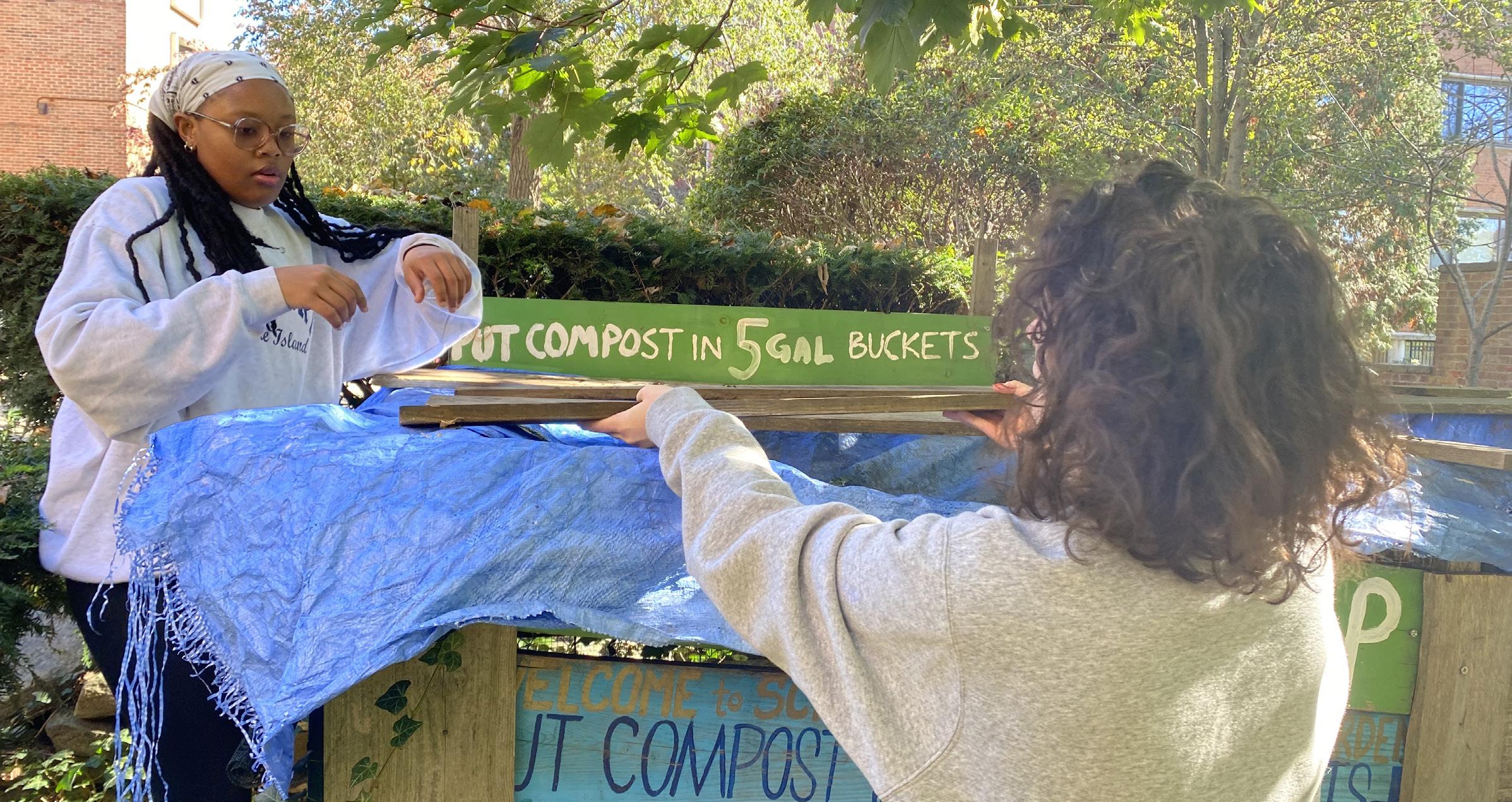
In an email to The Herald, Jessica Berry, director of the Office of Sustain ability, wrote that information on the destination of the University’s food waste can be accessed through the office’s website.
For Macher, it’s also important to consider the amount of non-food waste students produce annually. “As people are moving in and out of dorms, … they have full dumpsters on greens to handle waste, which is a little gross and upsetting to see,” she said.
Macher pointed out that in these situations, students have a respon sibility to manage their own waste, regardless of the University’s policies. “The life of a college student is just a lot of consumption,” she said, adding that “the best way to deal with waste is just not to create it,” and there is only so much the University can do to con trol how much its students consume.
Macher said that while there are many ways Brown can become greener, current University policies are more progressive than those at some other institutions. “I know of other colleges and I don’t think that they compost.
… It’s not a widespread practice,” she said.
Macher and Ligoo put their tools away and prepared to leave the gar den. “I’m gonna live to see the planet burning, but SCRAP makes me feel a little better,” Ligoo said, while waving goodbye.
SLUG: A relationship to land
According to Maru Attwood ’24, Students Learning Urban Gardening occupies a “small pocket of the stu dent garden.” While SLUG’s purpose is primarily recreational, Attwood high lighted the group’s broader interest in sharing knowledge about the natural world and fostering meaningful rela tionships with food.
Though the sun was already set ting, El Hebert ’24 joined Attwood at the student garden to help decorate a land acknowledgement sign. “Brown University is a settler institution. We live on land that was never forfeited by its original owners … so this sign has some information about how we want to establish that as a visible part of our relationship with the land here,” Hebert said.
Both Hebert and Attwood joined SLUG as first-years in 2020 in the height of the COVID-19 pandemic. “I would come out … and see the garden growing and filled with so many colors
ing for the continuation of affirmative action.
and flowers and gorgeous-looking pro duce. It would be the highlight of my day every time,” said Hebert, holding a paintbrush in one hand and a lantern in the other.
Speaking about ways to improve composting on campus, Attwood high lighted concerns about implementing front-of-house composting in Andrews Dining Hall because of potential con tamination from plastic containers.
According to Berry, Andrews uses a “back-of-house” composting sys tem. She also noted that the plastic containers are “currently under re view for ways to reduce the disposable packaging.”
Like Macher and Ligoo, Attwood highlighted how a culture of consump tion impacts the University’s waste system. “The ways the dining halls incentivize you to take lots of food and then throw it all away is a huge problem,” she said.
Attwood and Hebert’s motivations for participating in SLUG are both personal and collective. While they recognize that individual action has its limitations, it is also a natural ex tension of their worldviews.
“Individual action is not going to cause Andrews to put up a (front-ofhouse) composting bin that works, but what it can do is give people a model to change their imagination, … to make
it feel like something within reach,” Hebert said.
“I don’t feel at home in a place unless I’m growing something in it, so SLUG is very important to me,” Attwood said.
West House: Communities of care Hannah Saiger ’25 sat on West House’s porch as she explained its his tory. “It used to be a boarding house … specifically for commuter students” at Pembroke College, she said. In 1985, Brown’s housing council approved stu dent requests to designate West House as an Environmental Program House.
According to Saiger, the house’s mission is flexible, changing to accom modate the interests of its residents.
“In general, we try to source our food as sustainably as possible and create a diverse community of people living together that support each other.”
West House is one of the Univer sity’s two program houses dedicated to environmentalism. Selected stu dents are committed to reducing their environmental impact by sustainably sourcing their food and living collabo ratively. Residents are assigned house jobs and hold weekly meetings.
Saiger decided to apply for West House after a gap year. “I also felt very sad living in a dorm. … I think it’s pret ty unnatural … to not have any family structure,” she said, noting that she has
found a greater sense of connection in West House.
For Saiger, care for the community and care for the environment are one and the same. “I love coming home and there are people in the living room hanging out or cooking or playing a game,” she said.
While speaking to The Herald, Saiger was interrupted frequently as people came in and out of the West House. Saiger greeted each person with brief conversation before returning to the questions.
“At college, it is easy to feel dis connected from the environment, and (West House) has helped me recon nect,” she said.
When asked about the Universi ty’s environmental policies, Saiger highlighted that the most powerful changes can come from the student body’s demands. “As students we have the power to make (the University) care,” she said.
Saiger said the University has an institutional responsibility to make its campus more sustainable because of the amount of resources — land, food and energy — it consumes in Rhode Island. But for her, it is important that University policies are informed by the work that students in organizations like SLUG, SCRAP and West House have been doing for years.
like with much more diversity,” he said.
“You start to see graduating class es from Brown University that start to better reflect the makeup of not just the country,” Collins added, “but the world.”
When affirmative action has come up in the courts, Brown’s administration has repeatedly defended it. In 2003, President Ruth Simmons called for the policy’s expansion. In 2015, Brown sub mitted an amicus brief with 12 other schools in support of the University of Texas in Fisher v. University of Texas at Austin.
The University has again expressed support for affirmative action in these cases. has again expressed support for affirmative action in these cases. In February, President Christina Paxson P’19 told Bloomberg News that col leges “haven’t found a good alterna tive” to affirmative action to build a diverse student body. In August, Brown joined an amicus brief with 14 other colleges, including every Ivy League school not included in the case, call
Sean Fischer ’23 said he recognizes the central goals of affirmative action. But Fischer, co-founder and co-presi dent of the student organization Free Inquiry at Brown, which discusses “hot-button” issues, said he believes that the policy ultimately harms certain racial groups.
“Theoretically, greater racial di versity positively impacts all students by exposing them to people of various identities from divergent backgrounds,” Fischer said.
Fischer said he thought that by fac toring in race, colleges make admis sions a “zero-sum game” despite the intended merits of campus diversity.
Affirmative action unequally affects “every racial group … as is explicitly evident in the case of discrimination against Asian-American applicants,” he added.
Students for Fair Admissions’ case against Harvard argues that the school’s admissions process in tentionally discriminates against
Asian-American applicants, holding them to a “far higher standard” for admission than applicants of other racial identities.
Alexandra Herrera ’23, a member of the Brown Federalist Society, the University’s student-run chapter of a right-leaning legal group, added that affirmative action makes admissions difficult for Asian American appli cants “even though they may have higher test scores or other merits … (compared to) applicants from perhaps historically-disadvantaged backgrounds.”
On its website, Harvard notes that a commissioned study found “no evi dence of discrimination against Asian Americans” at the college.
“Harvard College does not dis criminate against applicants from any group in its admissions processes,” the website reads, pointing to an earlier U.S. District Court decision that ruled Harvard does not discriminate against Asian American applicants.
Beyond affirmative action’s ethical questions, Fischer said that he believes
that race-conscious admissions may be unconstitutional under Title VI of the Civil Rights Act of 1964, which outlaws discrimination or exclusion based on “race, color or national origin.”
Herrera said she suspects that the Supreme Court will rule against affir mative action, also citing Title VI of the Civil Rights Act.
“Universities, public or private, do accept public funding,” she said. “No government-funded programs are sup posed to discriminate on the basis of race, and this is discrimination.”
The end of affirmative action could be “potentially dangerous considering how many efforts have been made to ensure greater representation of peo ple of color” at colleges, said Niyanta Nepal ’25, a member of Students for Educational Equity.
A widespread commitment to test-optional policies could combat that loss of diversity, she said. A 2021 study showed that those policies led to a small increase in Pell Grant recipients and students from underrepresented backgrounds.
Universities should go test optional to “combat the (possible) decline in POC populations,” Nepal said.
“A lot of times, white people are primarily concentrated in education systems that have more access to re sources,” she added. “Test-optional pol icies can place a sort of limit on those disparities.”
During October’s hearing, the court also discussed legacy admis sions — preference in the application process for students with familial ties to a school. Nepal, Herrera, Fischer and Collins all separately said they support eliminating special consideration for legacy applicants.
Fischer said that while he does not believe schools will remove legacy sta tus from their applicant evaluations, he still thinks the process is unfair.
“For admissions to be truly based in meritocratic ideals, I would support the elimination of legacy admissions … from the admissions process,” he said, “regardless of whether affirma tive action is invalidated in college admissions.”
‘Blockbuster’ is lackluster addition to tired list of workplace comedies
is too much love in the air at Block buster for any of the romance to resonate.
BY ALEX NADIRASHVILI UNIVERSITY NEWS EDITORIn 2019, the Blockbuster in Bend, Ore. became the world’s last remaining location of the once-popular video store franchise. Blockbusters around the world shuttered largely as a result of enormous debt, legal issues and a national shift to streaming. But the Blockbuster brand has popped up in different film and TV projects, includ ing the 2020 documentary “The Last Blockbuster.”
Most recently, Netflix released “Blockbuster,” a workplace comedy series that follows the operations of the last Blockbuster in the fictional town of Iron Creek, Mich. Unfortu nately for Netflix — which, ironically, partially contributed to the franchise’s demise — the comedy is largely un remarkable.
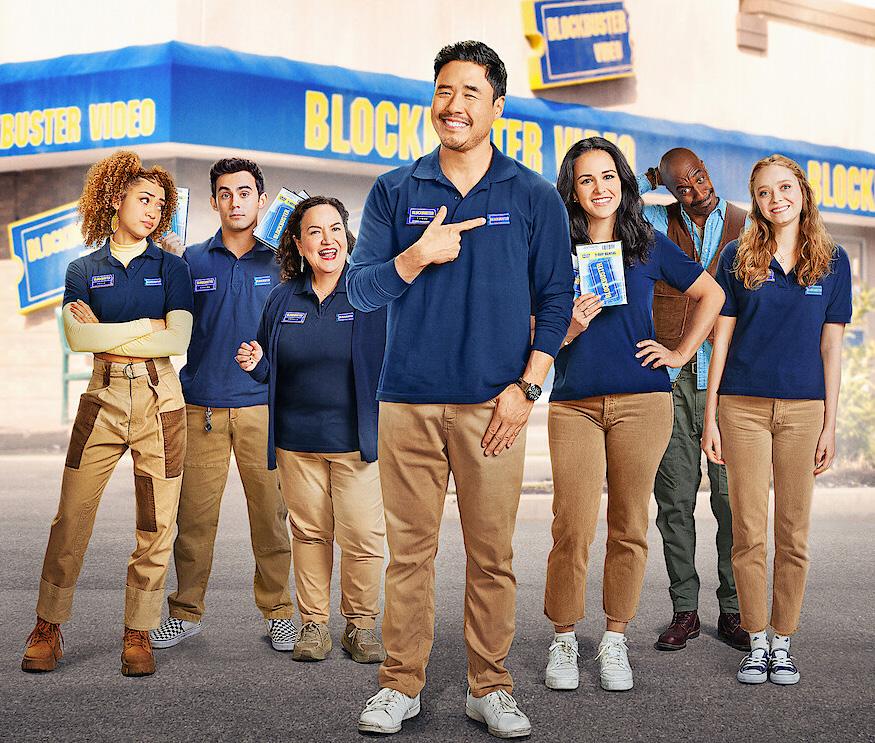
The series opens with Manager Timmy Yoon (Randall Park) being in formed by the franchise’s corporate office that his store is the last Block buster in the country. From there, the show follows an episodic format span ning several months as Timmy and his ragtag team of employees work to keep their store afloat with minimal corporate support. Storylines include Timmy trying to pick an employee to fire to cut costs and competing for a
small-business owner award to pay rent.
“Blockbuster” has all the ingredients that should make a successful comedy: an eccentric cast of characters, a unique workplace setting and a run-time short enough that the show never feels stale. And yet, the show fails to use these ingredients successfully.
One reason the show fails is that its setting feels too small for its own good. By the end of the first season’s 10-episode run, one cannot help but get bored of seeing the same empty aisles of DVDs and VCRs — and there are only so many ways to spice up the setting. After an extravagant block par ty, a Halloween-themed event and an
narrower. I think that’s really a dan gerous situation.”
in-store Santa Claus meet-and-greet, “Blockbuster” exhausted all variations to the dreary, beige walls of the video store in a single season.
Far too many romantic storylines also make the plot convoluted. The show is clearly trying to make its au dience root for Timmy and employee Eliza Walker (Melissa Fumero) to get together, constantly dropping ref erences to a will-they-won’t-they dynamic between the two characters when they were in high-school. But with Eliza simultaneously entertain ing a relationship with her ex-hus band Aaron (Leonard Robinson) and Timmy dating next-door business owner Lena (Stephanie Iszak), there
The largely uncompelling cast of characters doesn’t make it any eas ier for the show’s audience to be in vested in these couples. Nearly every character in “Blockbuster” is a cari cature of a tired comedy archetype. Timmy is the awkward team leader who is supposed to be funny because of his inherent unfunniness, but his personality is far more cringeworthy than humorous. Fumero’s character is uptight and one-dimensional — her personality is never fleshed out beyond mentions of her brief stint at Harvard University, a trope tired out by the infamous fictional Cor nell University alum Andy Bernard in “The Office.” Employees Connie Serrano (Olga Merediz), Carlos Her rera (Tyler Alvarez) and Kayla Scott (Kamaia Fairburn) don’t have enough screen time for the audience to prop erly engage with the few storylines they are given.
Percy Scott (J.B. Smoove), Timmy’s best friend and landlord, and employee Hannah Hadman (Madeleine Arthur) are the only characters that stood out, delivering the few comedic lines in the show that landed. Hadman specifically delivers absurd one-liners — which ref erence her chaotic and stingy lifestyle — perfectly deadpan. But even these characters are unable to save “Block buster” from lacking plot. The audience comes to understand why the actors in the show are not more famous — most of these performers don’t portray fleshed-out, likable characters.
But the actors aren’t entirely to blame for this mediocre series; the show’s script does them few favors. It’s difficult to deliver lines humorously when there is nothing actually funny about them, so the script and character dynamics in “Blockbuster” often feel forced. Several lines throughout the show serve as a way for the characters to indirectly speak to the audience, includ ing Eliza pointing out the absurdity of Timmy’s nomination for a small-busi ness owner award when he was very recently part of a major chain. While Eliza is correct in her observations, the actual line she delivers is awkward, elic iting a visceral and physical feeling of discomfortfeeling of discomfort from the audience.
“Blockbuster” also seems to be a step backward from more successful workplace comedies. Though similar in script and directorial style to other shows like “Superstore,” “Blockbuster” lacks the charm of similar ensemble TV. While shows such as “The Of fice” and “Parks and Recreation” are in no way perfect, their mockumen tary style makes it so every moment of awkwardness is purposeful and less cringeworthy. “Blockbuster” lacks this quirky element and thus doesn’t feel relatable or raw.
It’s difficult to imagine what direc tion “Blockbuster” will go in the future. After all, there are only so many seasons that an uninteresting will-they-won’tthey romance between Timmy and Eliza can support. Perhaps this show should meet the same fate as the franchise it owes its name to — cancellation and a lackluster legacy.
the framers’ hopes that the country’s original governing doctrine will prevail despite the inevitability of American life changing over time.
The framers “didn’t want peo ple’s only option to be constant in surrection against the government whenever they wanted to change things,” Lepore said. “They wanted change to be possible, but to also make (the Constitution) a little hard to mess with. It’s the classic Goldi locks problem.”
Lepore cited the two-party system as a principal factor inhibiting the pas sage of constitutional amendments, stating that “the emergence of the party system makes things a lot harder than (the framers) intended it to be.”
Briefly referencing the supermajori ty requirement for passing amendments in Congress — an amendment must have the support of two-thirds of both chambers — Lepore said that “people are not working on amendments be cause there is no future of amendments.
… State constitutions are really easy to revise by just asking people for a majority vote, but you cannot do that federally.”
Lepore then discussed the role the Supreme Court plays in constitutional change and implementation.
“The only way to change the Constitution became going to the Supreme Court and asking them to read it differently,” she said. “Juris prudence originalists” — such as Justices Clarence Thomas and Neil Gorsuch — “said we can only read (a handful of) documents in order to interpret it, which means that the way the Constitution can be read only got
Switching slides of her presenta tion to show a photo of Robert Bork, the 20th-century American judge and legal scholar, Lepore moved on to the fundamentals of originalist ideology and what it means for constitutional interpretation and ideas.
“In the 1970s, conservatives began advocating for a means of constitution al interpretation known as originalism,” she said. “Originalism presents itself as a mode of historical thinking when it is not. There is nothing about it that has anything in common with how histo rians investigate historical questions.”
Lepore then used abortion juris prudence as an example of originalism in practice.
“The point for originalists is like, if you want to talk about abortion, it has to be in the Constitution, or James Mad ison’s notes from the (Constitutional) Convention, or the Federalist Papers,” she said. “But you have an obligation to consult other sources.”
“Political theorists, people in power, framers, that’s great,” she said. “But what about everybody else?”
Lepore also argued that American people have almost religious reverence of the Constitution.
“A lot of people fall into the cult of the Constitution, but nobody cares about state constitutions,” she said.
“A lot of people propagated the idea that the Constitution came from … biblical readings and that the in terpretation should be the same,” Lepore said. “It’s a weird thing, and it contributes to the U.S. having one of the lowest amendment rates in the world.”
Lepore concluded her presentation
with the proclamation that the Consti tution is “effectively unamendable.”
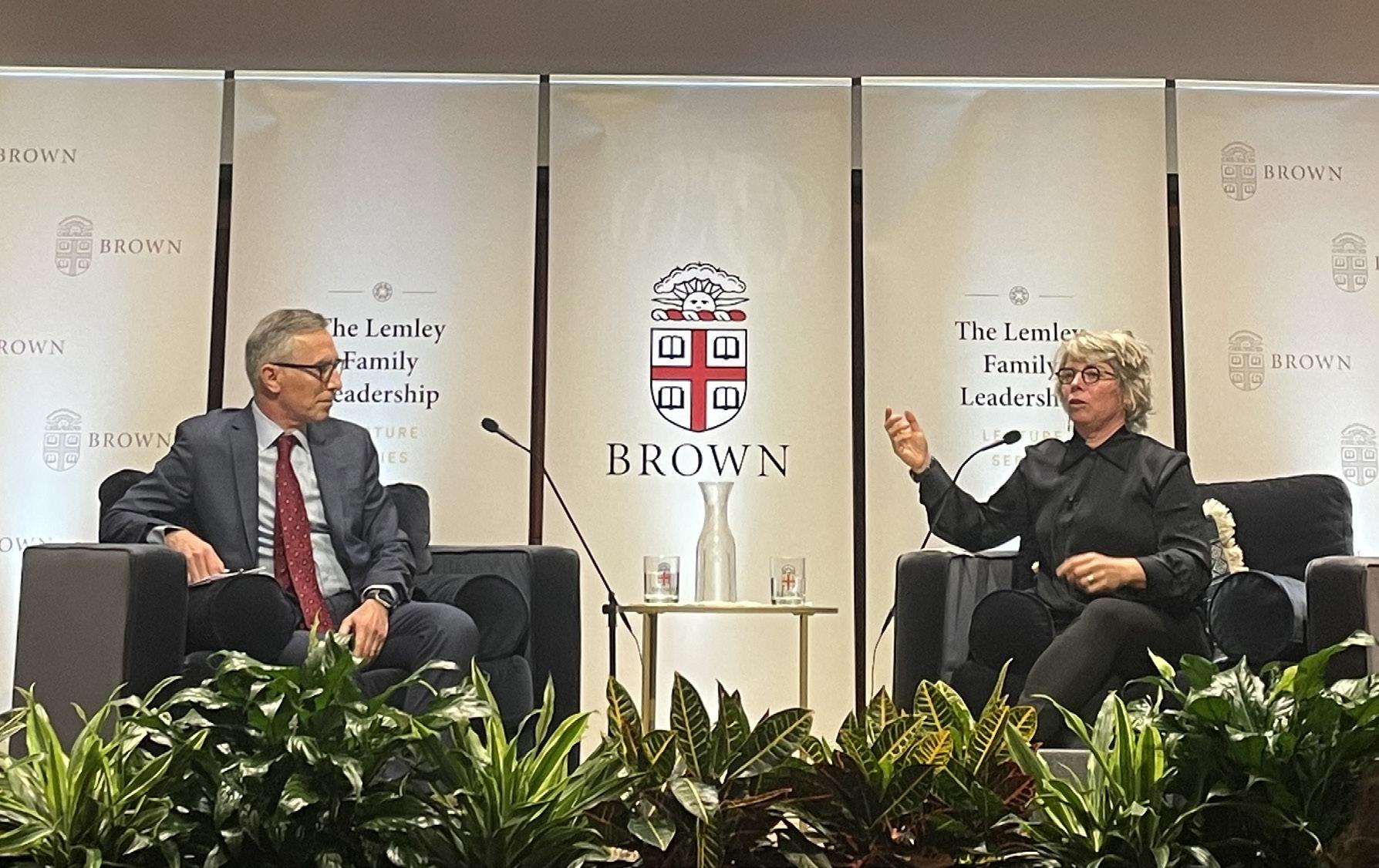
In the question-and-answer session moderated by Locke, Lepore was asked her thoughts on constitutional legiti macy and how passing constitutional amendments could be made an easier process.
“On one side we see conservatives who believe we should be holding con stitutional conventions and (on the other side) progressives who tend to be opposed to this,” Lepore said. “It’s one of those difficult moments where possibly the only solution is bipar tisanship, which feels like almost a dangerous word to say in an audience like this.”
Another question asked Lepore her
opinions on the roles of celebrities and influencers in political discourse, point ing to politically engaged public figure Dwayne “The Rock” Johnson.
“People just need to get togeth er and argue about things that don’t matter to get more comfortable with disagreeing and compromising and forming a coalition to change. I don’t necessarily think there’s any role for Dwayne Johnson there,” she responded.
“I think the role of Dwayne Johnson is to just sit down and join a knitting group.”
“But anyone who is entering public office needs to take responsibility for public discourse,” she added.
William Loughridge ’26 commended Lepore’s response, calling it “engaging”
and “succinct.”
“I didn’t really know what exactly she was going to talk about beforehand, but… she made me want to go out and fix things,” he said. “I am so jealous that she teaches at Harvard and not at Brown.”
Gabby Smith ’23.5 echoed Loughridge’s sentiment, saying that “Lepore was a really great speaker.”
“I really liked how she brought in historical examples and juxtaposed (primary sources) to really show why we can’t take the Constitution at face value as originalists do,” Smith said. “With the use of metaphors and real political examples, I think she made her points in a very swift and engag ing way.”
New Netflix original features forgettable characters, plot riddled with excessive romanceCOURTSY OF NETFLIX MEDIA The script and character dynamics of “Blockbuster” often feel forced, making most attempts at humor cringeworthy and uncomfortable. SOFIA BARNETT / HERALD Jill Lepore began her lecture by thanking the crowd for “coming out to think about the U.S. Constitution” and expressed her “own frustration with the brittleness of our political discourse” around the Constitution. LEPORE
Peng ’26: Productivity culture makes it impossible to relax
Go on
In the search bar, type “produc tive college day in my life.”
In seconds, you will see hundreds of vid eos meant to be inspirational: “study diaries | college days in my life, library, productive study vlog,” “an early & productive college day in my life (waking up at 5am),” “another early 7am productive day in my life.” You Tube has an entire subgenre of hardworking students who wake up early in the morning and then study past midnight — without ever stopping.
These “study with me” videos seem to be an attempt at nudging viewers toward a more pro ductive lifestyle. But if you are someone like me, watching these students may sometimes bring you guilt. When I watch these videos while taking a break, they often make me won der whether I am wasting my time and should be working instead.

Productivity culture, or hustle culture, is a societal pressure to maintain a high level of productivity. It demands that you are constant ly working — whether that be in the context of your job, school or personal goals. It glamor izes the idea of overworking yourself, telling you that your self-worth is measured by how productive you’ve been. It’s a voice inside you that says, “No, you cannot feel good about your self until after you have checked off your to-do list.” As you lay in bed, scrolling through posts about people who work 12-hour days, produc tivity culture screams at you to get up and get to work.
There is nothing wrong with pursuing a pro ductive lifestyle, but a problem arises when our need to be continuously accomplishing some thing becomes our ultimate priority. Relaxation, despite being essential to our health, is often frowned upon. Instead of feeling rested from taking time off work, we end up feeling guilty.
Yet it is integral that we prioritize our own re laxation to avoid the detrimental effects of hus tle culture.
Living a busy lifestyle has become an “aspi rational status symbol,” according to a series of studies published by Columbia Business School. Researchers found that individuals that appear to lead overworked lifestyles are perceived as higher in status and human capital characteris tics such as competence and ambition. For ex ample, participants in one study were assigned
However, attributing status to productivi ty is problematic, especially in the workplace. Instead of encouraging people to work harder, an obsession with productivity leads to burn out, which can contribute to further physical and mental health issues such as heart disease, diabetes and depression. Moreover, a work cul ture driven solely by achievement can cause employees to increasingly prioritize measur able gains over long-term company goals that do not produce immediate results — for in
has become crucial to our making a living. As Jenny Odell explained in her keynote talk on her best-selling book “How to Do Nothing,” “when we submit even our leisure for nu merical evaluation via likes on Facebook and Instagram, … time becomes an economic re source that we can no longer justify spending on ‘nothing.’” The expense of idle time is too great, and fewer and fewer people are willing to pay it.
to read Facebook updates from a hypothetical friend. Participants saw either all busy updates — “quick 10 minute lunch” or “oh I have been working non-stop all week” — or all leisurely updates — “enjoying a long lunch break” or “I haven’t worked much this week, had lots of free time.” Then, participants were asked to rank this friend across various characteristics: so cial standing, human capital, demand in the job market and more.
Researchers discovered that the friend was perceived as higher in social status and desired human capital characteristics by participants who saw busy Facebook posts. Participants that saw the busy posts also ranked the friend as more in demand. The results demonstrate a so cietal attitude that assigns higher status to bus ier individuals.

stance, choosing to write reports rather than mentor new employees. Toxic productivity culture then becomes counterproductive. The constant pressure to “visibly perform” and power through each day inhibits employees’ ability to learn and imagine new possibilities — which the brain can only do after a well-de served break.
Workers have celebrated the value of lei sure time in the past. In 1866, amidst the bru tal working conditions of the Industrial Age, the push for an eight-hour workday called for “eight hours for work, eight hours for rest and eight hours for what you will.” A labor song from the era describes the potential of those “eight hours for what you will” evocative ly: sunshine and flowers. Yet in the current day and age, it is as if every waking moment
There’s an obvious critique to the idea of doing nothing — that it comes from a place of privilege. But while the ability to do nothing is out of reach for many, gaps of solitude and si lence should be a right. The solution to break ing out of productivity culture is to redefine productivity for yourself. Ask yourself: What is the most productive thing I can do for my self and my well-being? This could be a variety of things such as meditation, listening to mu sic or watching a guilty pleasure show. Unfor tunately, relaxation is often difficult because social media and your current work environ ment may already give you a general definition of what productivity looks like: more complet ed tasks, longer hours and fewer breaks. When you change your own definition of productiv ity, you may be going against the norm. That is okay. Don’t look to society for validation.

If you overwork yourself, you must take time off to avoid facing the effects of burnout. It is important to remember that, sometimes, the most productive thing you can do is nothing at all.
Christina Peng ’26 can be reached at christina_peng@brown.edu. Please send responses to this opinion to let ters@browndailyherald.com and other op-eds to opinions@browndailyherald. com.
Submissions must include no more than two individual authors. If there are more than two original authors, The Herald can acknowledge the authors in a statement at the end of the letter or oped, but the byline can only include up to two names. The Herald will not publish submissions authored by groups. The Herald does not publish anonymous submissions. If you feel your circumstances prevent you from submitting an op-ed or letter with your name, please email herald@ browndailyherald.com to explain your situation.
You can submit op-eds to opinions@browndailyherald.com and letters to letters@browndailyherald. com. When you email your submission, please include (1) your full name, (2) an evening or mobile phone number in case your submission is chosen for publication and (3) any affiliation with Brown University or any institution or organization relevant to the content of your submission.
Commentary:
Corrections:
“Sometimes, the most productive thing you can do is nothing at all.”
U. selects two architecture firms to design life sciences building
in an email to The Herald.
BY JARED ZHANG SENIOR STAFF WRITERThe University has selected architects from Deborah Berke Partners, a New York City-based architecture and in terior design firm, and Ballinger, an engineering and architecture practice headquartered in Philadelphia, to de sign the new integrated life sciences building in Providence’s Jewelry Dis trict, according to an Oct. 17 press release.
After announcing the project in June 2022, the University interviewed a pool of firms interested in designing the building, according to University Spokesperson Brian Clark. Following this initial process, 14 architecture firms were selected to submit their proposals for the building, out of which four finalists were ultimately interviewed.
A commitment to sustainable de sign practices and previous experience developing academic research facilities and working in urban environments were key factors in identifying design teams for the new building, Clark wrote
“Both Deborah Berke Partners and Ballinger have extensive experience in working with academic institutions on complex, large-scale projects and have also partnered individually with Brown,” he added. DBP is currently part of the team of architects working on the William and Ami Danoff Res idence Hall and 250 Brook St. dorm. Architects from Ballinger previously designed the Sidney E. Frank Hall for Life Sciences.
When selecting firms, the University looked “carefully at the values of the firm and their ability to understand” the University’s mission, said University Architect Craig Barton. A collaborative spirit among the firms was central to the assessment, he added.
DBP focuses on creating a sense of community among the different indi viduals involved in and affected by its projects, according to Noah Biklen ’97, a partner at the firm who is leading the design team for this project. “We’re really interested in a building that is connected to the broader community in which it sits,” he said. “We want a building that’s great for science, great for scientists and also great for the community.”
“Academic buildings need to be en vironments where people can work pro ductively and collaboratively,” Biklen added. “Architecturally, that ends up
being (a space) with connection to the outdoors and (access) to light.”
DBP is also focusing on sustainable design in the new building, which aligns with the University’s goal to reach net-zero carbon emissions by 2040, according to Biklen.
“This building has a real opportu nity to set a standard for Brown’s … science buildings,” he said.
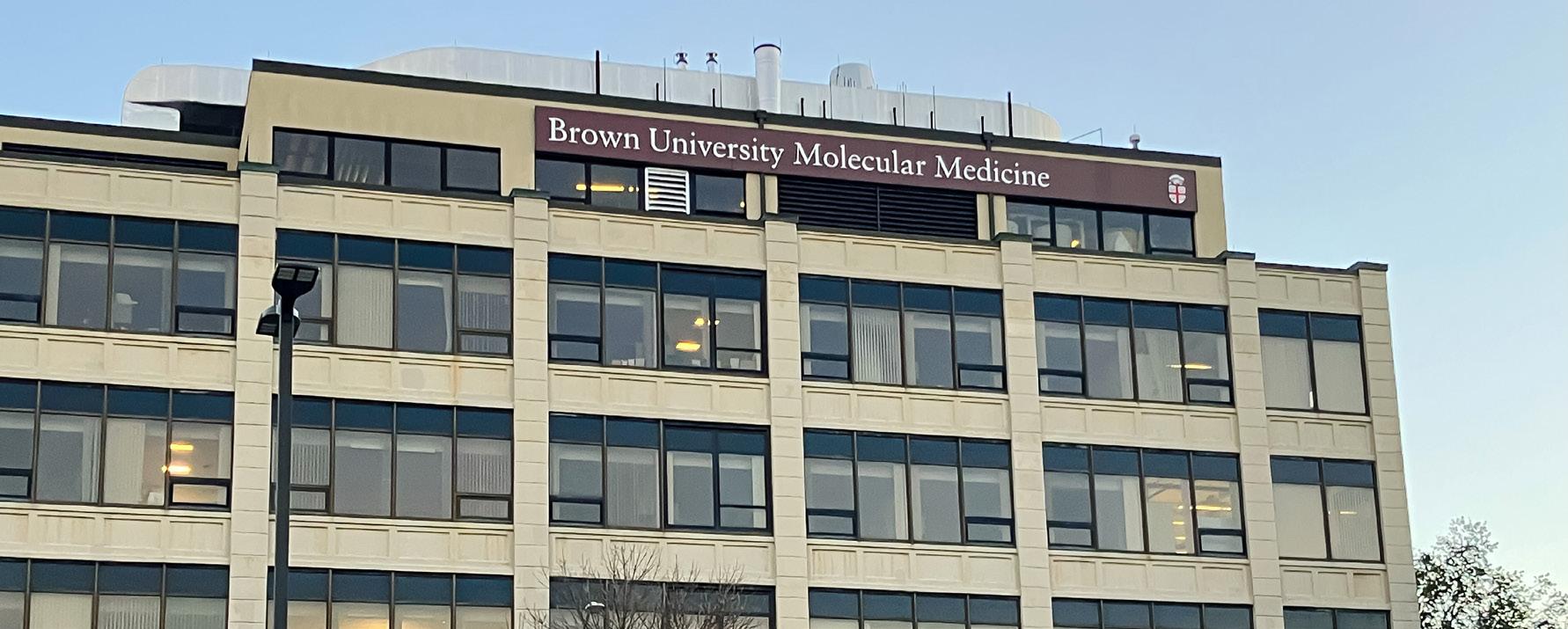
Ballinger will be focused on making sure the project fulfills the functional requirements necessitated by work in the sciences, creating a building that “is not only relevant to science today, but also has the (flexibility) to evolve” as science changes over time, said Terry Steelman, senior principal at the firm. DBP and Ballinger will collaborate
to fulfill their different responsibilities and bring their unique experiences to the project, he added.
But before creating plans for the building, the team will hold “in-depth” engagement workshops with stakehold ers and user groups, Biklen said. These groups include principal investigators, researchers, facilities and operations workers and members of the surround ing community.
The University also plans to launch “extensive programming … that will assess factors ranging from space needs and site requirements to conceptual design and projected scale and scope, as well as estimated project costs and funding sources,” Clark wrote.
While a specific location in the Jew
AFTER SCHOOL
elry District has not been identified for the new building, the team plans to complete construction in 2026, barring any possible delays caused by the need for external approvals, according to Barton.
This project will be an “incredibly transformational (one) for Brown — both in the sciences (and) also in terms of its footprint in the Jewelry District,” Steelman said.
“We are incredibly excited about the prospect (of) creating an integrated life sciences building in the Jewelry District,” Clark wrote. “The selection of the architecture team marks the next critical step toward a long-term process in realizing the vision for this building.”
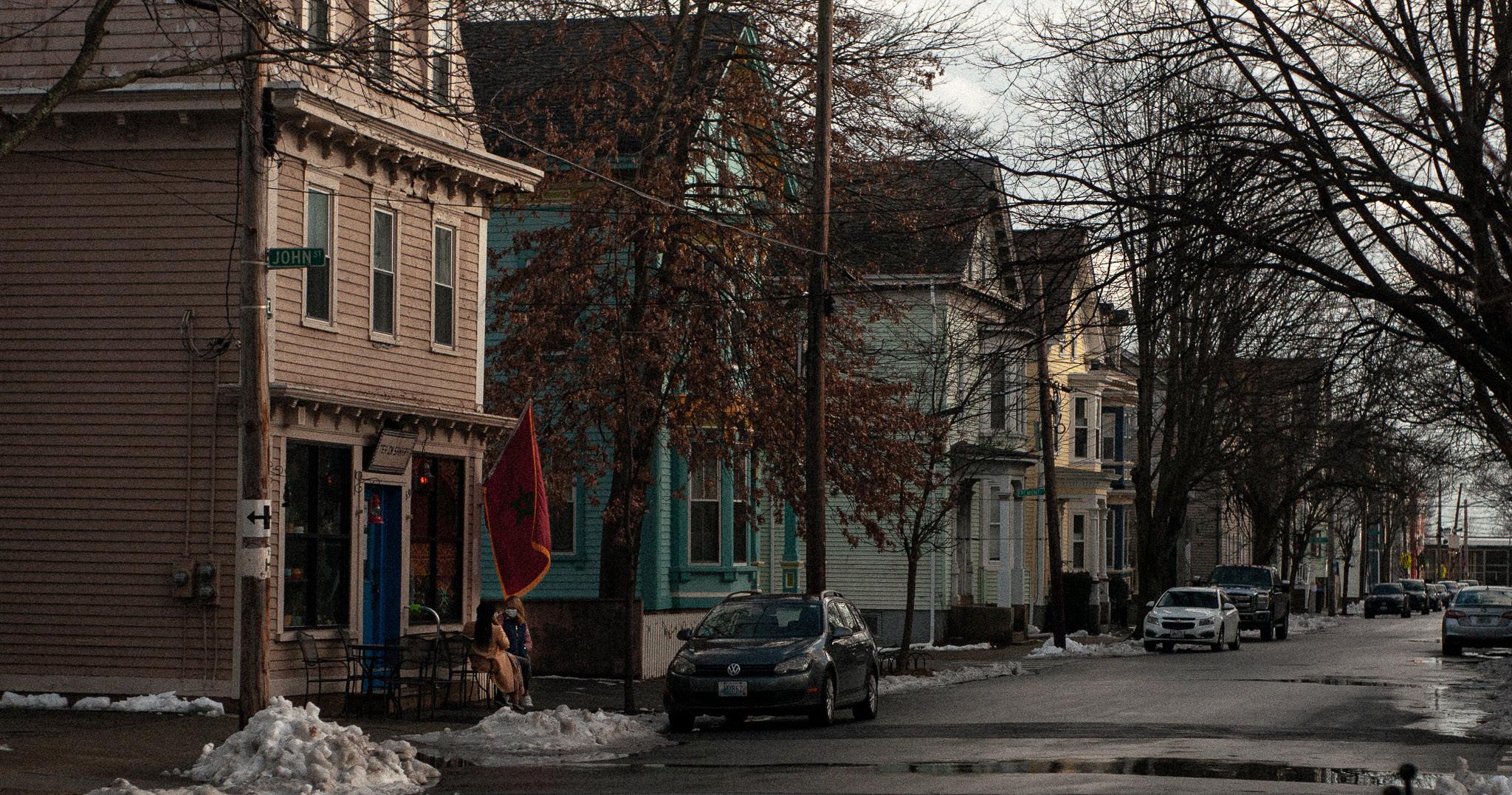
It’s 3 p.m. — you’ve just made it to your home street. The bright yellow bus that should’ve brought you back has long since departed, leaving you to make the trek from high school.
But you’re not alone. Your best friend is walking alongside you. You both lug your field hockey equipment from afterschool practice, chatting and laughing through tired breaths. They’re the reason you’re both in this situation — their antics caused you to lose track of time and miss the bus.
Suddenly, your morning alarm wakes you from your dream. You move to turn it off, only to find that it’s 8 a.m. and you’re in your college dorm room. You leave this memory in the sheets while getting out of bed. As you start to get dressed, you realize that you’ve run out of socks. That’s alright — today is laundry day.
I miss you, friend.
TODAY’S EVENTS
Brown University Women’s Voleyball vs. Harvard 7 p.m. to 9 p.m. Pizzitola Sports Center
SoBear Painting and Karaoke Night 7 p.m. The Underground
TOMORROW’S EVENTS
Brown University Football vs. Columbia 12 p.m. to 3 p.m. Brown University Stadium
Sounds@Brown November Show 7 p.m. Leung Gallery
Film Screening - Summer of Soul 7 p.m. to 9 p.m.
Watson Institute for International and Public Affairs
Shut Down: TEMPO Performance Co. Fall Showcase 7:30 p.m.
Salomon DECI Auditorium
Chamber Music Recital - Brown University Department of Music 2 p.m. Grant Recital Hall
Two Mile Hollow by Leah Nanako Winkler 8 p.m. to 10 p.m.
Stuart Theatre
Firm values, previous experience cited as critical factors in selection processANDREW ZHONG / HERALD Deborah Berke Partners, the architecture team behind the William and Ami Danoff Residence Hall and 250 Brook St. dorm, will work with Philadelphia-based firm Ballinger to design the new life sciences building. RYAN RHEW / HERALD
to: the dictionary xoxo
how i learned to stop worrying and love words
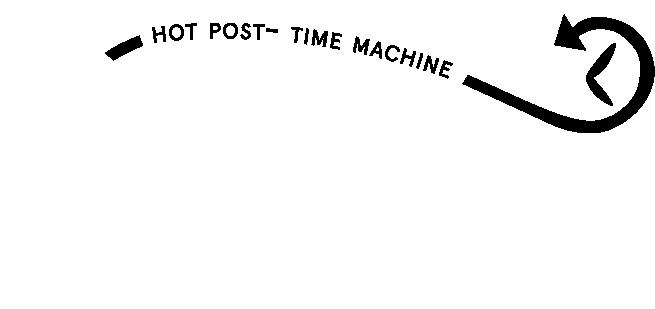
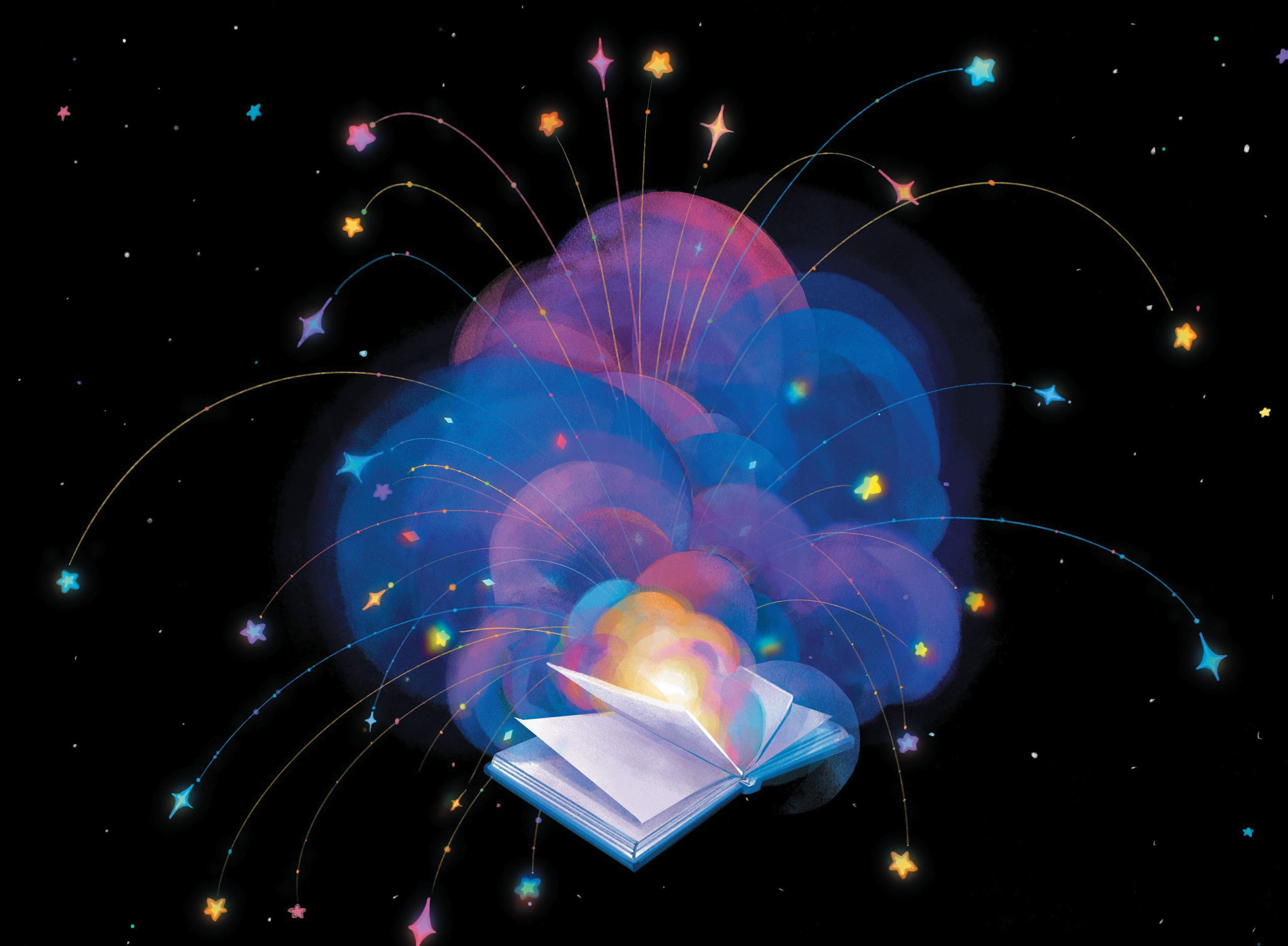 by DANIEL HU illustrated by Kianna Pan
DANIEL HU (noun)
by DANIEL HU illustrated by Kianna Pan
DANIEL HU (noun)
the hipster poser who will spend the next ~1600 words creaming his pants over the idea of words
My Latin teacher in high school made me love the dictionary, which is a weird-ass book to claim to love.
She loved to connect English words to their Latin roots, and she spent huge portions of class time tracing the words on our weekly vocabulary lists to their English counterparts. She kept an enormous dictionary in the corner of her room with thousands of thin pages delineating the precise linguistic genealogy of each word. It was one of those dictionaries that was so big that it had its own dedicated book stand.
Not gonna lie, it was a massive pain in the ass to use, unwieldy and heavy and with text so teeny and crammed that you had to squint to make anything out. It takes a masochist to love a book like that— which I, in fact, am. To me, dictionaries aren't just utilitarian collections of “meanings” of words. Dictionaries contain family trees and huge sprawling stories hidden between the definitions. Dictionaries were maximalist literature before Thomas Pynchon
made it cool.
My Latin teacher’s favorite word was colere. Colere means to cultivate, both literally and figuratively. It can refer to farmers tilling the land—in fact, the Latin word for farmer, agricola, comes from a compound of ager (field) and colere (to cultivate). But colere also indicates the figurative sense of cultivating, to honor or to worship. In the Aeneid, when Virgil describes how the goddess Juno loved the city of Carthage more than all the rest of the world, Virgil uses the word colere. To cultivate is to cherish, to love, to worship.

We see this reflected in the perfect passive participle of colere, which is cultus. This form of the word is where we get English words like “cult.” It’s a word that’s taken on a negative connotation recently, but in its most essential form just denotes a system of religious belief, usually centered around a religious figure or object of worship.
We also get the form cultura from colere. It’s where we get the English word “culture” from, along with all its compounds. If the root of “culture” is worship, that means that all culture is fundamentally a form of worship ...
bruce lee, messiah lord
master savior redeemer
shifu
by Daniel HuI. FOURS
Scripture teaches us this: All Creation is made in the image of Bruce Lee.
The basic structure of Bruce Lee is the quadripartite structure: two arms and two legs, four instruments with which He might inflict violence.
This we derive from Fist of Fury, in which Bruce Lee found finds a sign which said this: “NO DOGS AND CHINESE ALLOWED.” Bruce Lee beheld this and His fury grew to immeasurable heights and He performed a flying jump kick and obliterated the fuck out of the sign and the tiny white fragments of this sign rained across the screen so that all might know that the contents of this sign run contrary to His designs. And Bruce Lee saw this destruction wrought by His own hand and said it was good. Therefore Bruce Lee had, with his four instruments of divine justice, made the world safe for the CHINESE.
We also derive this universal quadripartite structure from language. In Mandarin, the number four, , is unlucky because it sounds like , death. Bruce Lee uses His four celestial limbs to inflict death. This is not a coincidence. The tongues of us CHINESE have warped to accommodate these cosmic instruments of violence ...
A friend once told me that he thinks Californians grow up thinking life is easy because they don’t have to deal with bad weather. He’s not entirely wrong: Aat home, the seasons melt into each other almost unnoticed—the sun shifts its shade, the wind picks up a chill, suddenly it’s dark at 4 p.m. San Francisco’s hills get their few weeks of winter sun. Crowds of children biking to school thin out a little, the city bus starts to run late from the traffic. Little indications of time slipping away.
—Anneliese Mair, “A Brief History of Sorry” 11.01.2019
The first time I fell for a girl, it was summer and I was spending a week in Ohio for a writing workshop. The asphalt burned in the sun, and everything felt a little fake and liminal. The air smelled heavy with cut grass and humidity, and at night the cicadas would fill the wind with their shrieks. Once, walking back from a late night swim, we got lost and almost stepped on a frog, squealed and laughed. I barely said anything all week, and she made fun of me for it, just a little. That was the year I first learned what frozen custard was, and first fell in love with someone else’s poems ...
“However, I am lulled into a hushed contentment by remembering the places I carry with me and the memories they have left.”
— Nicole Kim, “Tea, Coffee, and the Dying Day”
“When I declare that I am Sorry, I modify myself; I place myself in a shallow space to be received by a nod, an acceptance of stability or its attempt.”
as the leaves do on queerness, weather, and whatever else the wind brings with it
it's lamp season
sugar and spice and everything lights
by Marlena BrownThe end of daylight savings is here. Nights come earlier and days will soon be overcast. That is to say, light will be a scarce resource. We’re all poorly adapted to see in the dark and prone to vitamin D deficiencies. So it’s the time to get creative and embrace sun alternatives—it’s lamp season.
The case against overhead lighting is simple: it’s too bright. During the day, I don’t need to replicate the sun when I can simply open the blinds. Still, on a cloudy, snowy winter’s day, plunging my room into mild grayish light doesn’t inspire high spirits. The easiest fix to drastically improve the room’s mood is to switch on a bedside or desk lamp (imagine: the beautiful duality of color—the warm glow from the lamp contrasting with the cool tones reflecting off the snow).
At night, lamps are even more vital. Have you ever gotten a headache from sitting up at night, working on a computer screen with the overheads shining down on you? Been saddened by the fact that your room looks like a hospital or high school gym? Felt like you were standing in the middle of a football stadium with all the lights on? Blame overhead lighting.
Of course, the difference between lamps and overhead light is specifically the color and intensity of
ARTSLIFESTYLE & CULTURE
the lighting. Naturally, a lamp decreases the intensity of light, which you can change at will by adding or subtracting the number of lamps. But a lamp also does nothing for the mood (aka vibez~) if the bulb is still a bright, glaring white. Warmer lighting creates a softer, cozier, more inviting space. Choose a bulb anywhere from 3000 to 1500 Kelvins depending on your personal preference for how warm you want the lighting to be. The lower in Kelvins, the warmer the light (the more reminiscent of firelight).
If lamps aren’t your thing, window decals are a fantastic option—they throw the room into various assorted colors, and can come in abstract stained glass patterns. Many of them are not as ugly and home-decor-esque as they might sound. There’s also the even sparklier option: sun catchers. These are great because they’re the exact sort of thing you can find being sold on Etsy by a 50 year old lady who enjoys birding and wears a lot of beads. Maybe you’re the sort of person who wants your living space to look like it was decorated by her (me), but if not, at the very least, she’ll make the buying experience more enjoyable.
The final and most important part involves choosing the lamp(s). You can make it a project—pick lamps to fit the look and feel of the space ...
“At least I didn’t do coke this weekend… I did coke LAST week”
“Aw we’ve never hard launched darkness before”
Apples
the formula for the final girl
a reflection on trauma and female survival
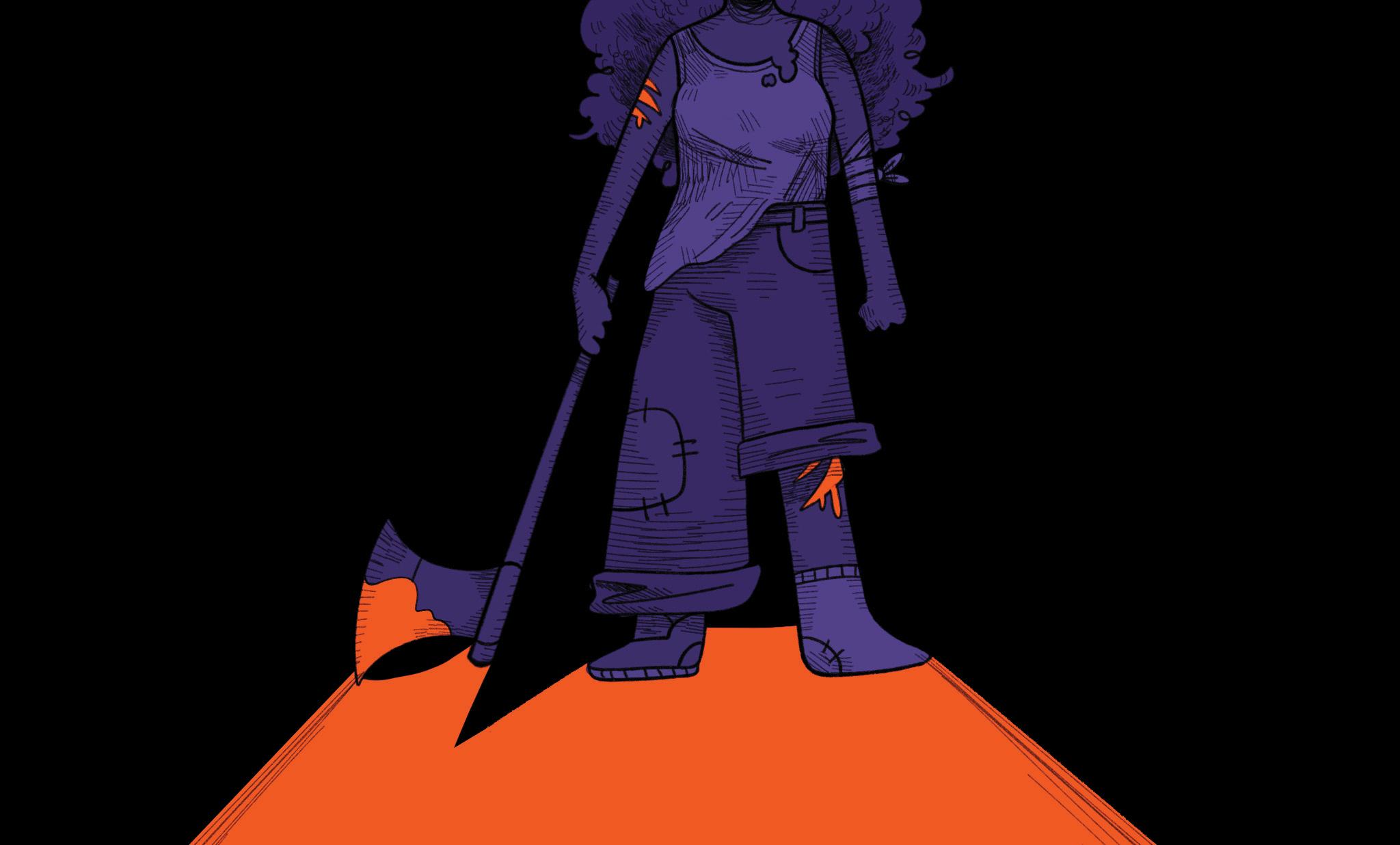 by Malena Colon
by Malena Colon
illustrated by Lena
Maybe Laurie should die.
He Insta: @liquidbutterfliesI can’t help thinking this as I watch the final battle in David Gordon Green’s Halloween Ends—the latest (and perhaps final) installment in the slasher franchise that began some forty years ago. Laurie Strode (Jamie Lee Curtis) faces Michael Myers (James Jude Courtney) yet again, for what us viewers have been told will be the last time. And so, knowing that it will end, we are left to wonder how it will end. Who will live and who will die?
For the audience, there’s a sense of inevitability
Email: kyoko_leaman@brown.edu!
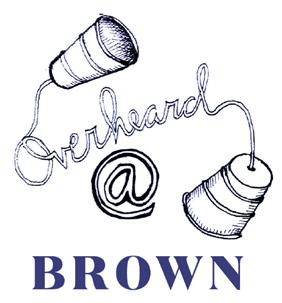
that one side will triumph over the other; we’re a society plagued with binaries, after all. And if there’s any binary that the Halloween films enjoy, it’s good versus evil. However, while watching this scene, I can’t help but wonder if they’re really going to do it. If not just Michael will die—but Laurie, too.
Knitting needle in hand, Laurie takes up arms against her lifelong tormentor—an homage to how her character originally “killed” Michael in the first Halloween. But it’s a different struggle this time. Michael quickly turns the needle back onto her ...
acne girl’s
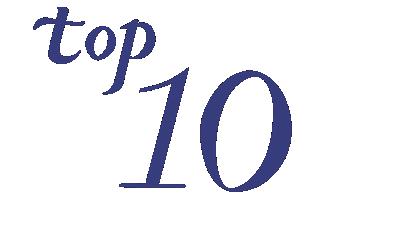
to skincare
guide
and the toxic self-help agenda
by Leanna BaiGlass skin.
Upon reading this term for the first time, I was a little puzzled: is it referring to a condition that makes skin transparent? Would it shatter into tiny pieces?
In reality, “glass skin” refers to skin that is bright, poreless, and completely smooth—a trend that emerged from Korea and made its way to the West in recent years. According to the endless TikTok videos that I’ve watched, one achieves “glass skin” when they appear to glow from within; in the process of laying products on top of other products, skin somehow achieves a divine, transcendent quality.
They become an ethereal, luminescent goddess.
And you can be one, too!
Introducing the all-inclusive package “Acne Girl’s Guide to Skincare!” Have you ever felt lost in the complicated and beginner-unfriendly process of developing a lasting skincare routine? Are you terrified of pimples? Of aging faster than your classmates? Of the ten year reunion when you will look significantly more shriveled than everyone else and spiral into a pit of existential dread, then wonder when your youth escaped you? Allow me to take you on my own journey and show you just how attainable flawlessness can be…
Step One: Cleanser —
The first and most important component of selfimprovement is self-reflection ...
“I mean, I can imagine… It was called the worst looking Subaru for a reason.”
history more broadly.
In February 1919, the Navy conduct ed an investigation at its Newport base to prosecute men who were having sex with other men. The trial that followed resulted in the Newport sex scandal, for which 15 men were arrested on the charge of homosexuality. In a paper titled “Out of the Closet and Into the Quad: The Origins of Brown Gay Liber ation,” Sarah Yahm PhD ’17 writes that “this was the moment when homosex uality stopped being an act and became a type of person.”
One year after the scandal, the Ivy League had its own queer calamity — Harvard expelled several gay students after conducting an investigation by a secret tribunal to uncover their identi ties, according to The Washington Post. When one of the expelled students tried to transfer to Brown, the president of Harvard intervened, informing Brown Dean Otis E. Randall of the student’s sexuality.
In response, Randall sent a letter of thanks: “You have given me just the in formation which we needed, and it goes without saying that we shall inform Mr. Lumbard that we do not care to consider his application for admission to Brown … How frequently we uncover in the undergraduate life messes of this sort, and how disagreeable it is to deal with such matters!”
“Such matters,” as Randall put it, were infrequently visible on Brown’s institutionally intolerant campus, or in Rhode Island generally. Though small, undiscovered queer communi ties sometimes formed in subcultures of Providence nightlife, these groups existed in secrecy, according to queer historian of Rhode Island Kate Mon teiro.
In the 1960s, slowly forming queer communities were met with violence. On Oct. 29, 1965, The Providence Jour nal reported that “Providence police have stepped up their efforts to curtail homosexual activity in the downtown business district, where homosexuals recently have gathered in increasing numbers.”
Kate Bornstein ’69, a queer the
orist, remembers no openly queer people on campus during her time at Brown. She participated in the ater on campus, in which people were definitively queer — “though that doesn’t mean everybody was homo sexual,” she said, explaining that she sees queerness as deviation from the norm. “I’m using queer in the sense of ‘wouldn’t be proper in your aunt’s tearoom.’”
There was no queer community at the time, Bornstein explained. Though individual students would cruise, or walk around in search of a sexual part ner, in downtown Providence or go to New York to model in drag, these in stances were isolated and undiscussed, she said.
There was no open expression of gender ambiguity at Brown until 1967, Bornstein explained. “That’s when the hippies happened. Suddenly I could wear purple bell bottoms, flowered shirts and beads and still be a guy. I suppose there was a whole lot of trans gender expression going on in New York and San Francisco, but not at Brown,” she said in an interview with News from Brown.
In secrecy, Bornstein “would sneak into the wardrobe department of the theater at 2 a.m.,” she said. “I would pick out a princess outfit, a Shakespear ean queen, ball gowns. I’d get dressed up and (look) in the mirror, and it just felt so right.”
Though Bornstein had never expe rienced direct harassment, queer peo ple were often openly discriminated against.
A letter to the editor of The Herald, published Oct. 30, 1973, detailed the harassment Daniel Paige ’62 experi enced as a queer male student. “In form the Brown community that, yes … there were gays at Brown ten years ago,” he wrote. As a student, Page’s room had been “ransacked and pillaged by anti-homosexual bigots from the neighboring fraternity.”
But by the time Page sent his letter, one decade after his graduation, queer life was starting to change. “And inci dentally,” he wrote at the end of his piece, “is there a gay activist movement at Brown?”
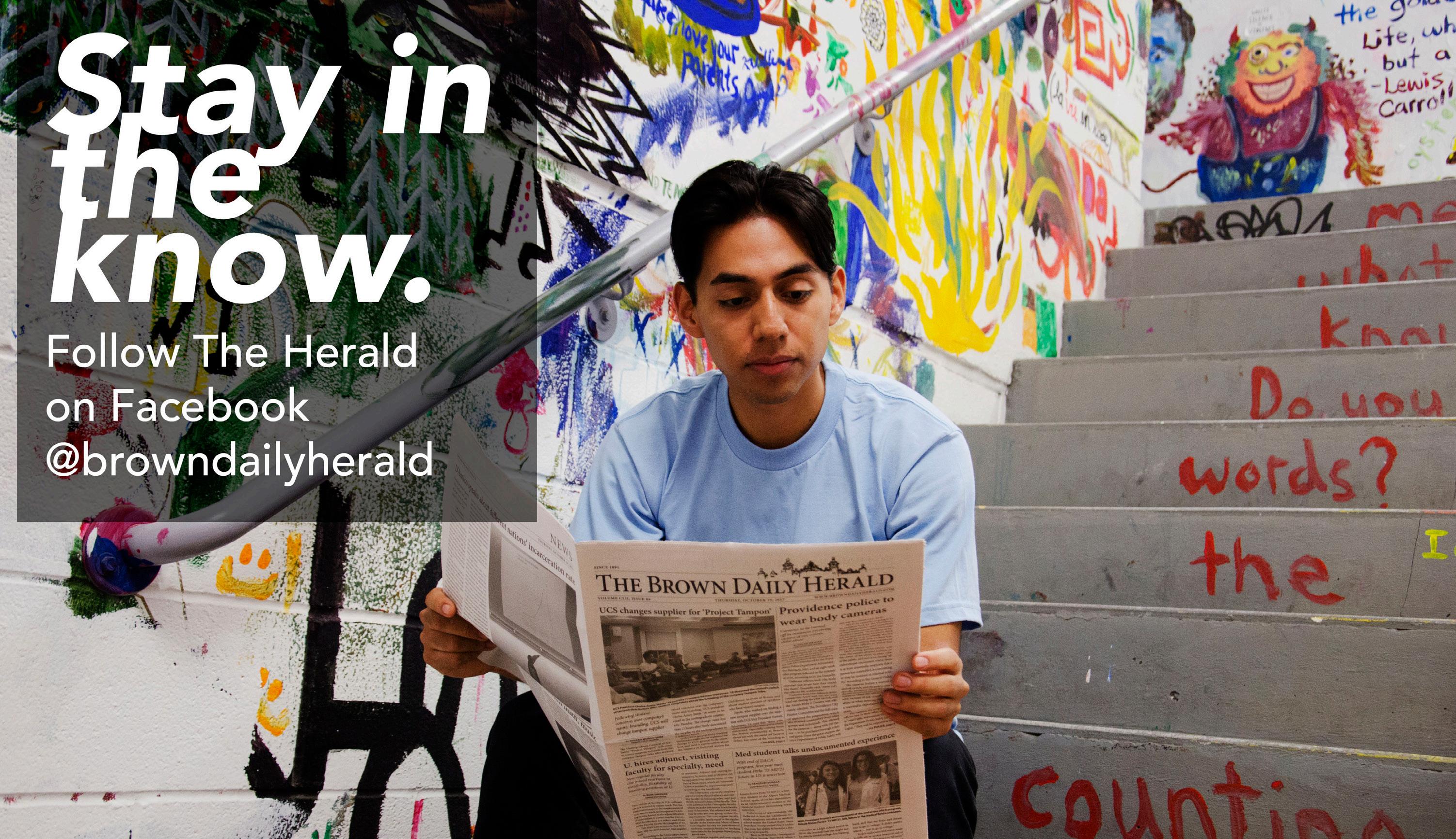
1968-1979: The Gay liberation years
Gay liberation at Brown officially began in the early 1970s. Tom Littler ’72, one of the leaders of BUGL put a notice for the club’s first meeting in The Herald Dec. 15, 1971.
The group was run by Littler and his boyfriend James Moser ’72, along with their friends Jack Marcus ’71 and George Heymont ’71. Their existence on campus was revolutionary — Lit tler and Moser held hands publicly and wore pins that read “Out of The Closet” and “Gay” — though relatively unnoticed.
It took several years for BUGL to gain traction on campus. On Oct. 30, 1973, The Herald published an article titled “Gay Liberation Comes of Age” announcing the group’s plans to orga nize and expand over the coming year.
Later leaders petitioned for BUGL to have an office in Faunce House, and through their work, a queer scene on campus finally took off. BUGL’s orga nizing work continued alongside ha rassment of queer students — after a Gay Lib action in the early 70s, a fra ternity plastered campus with posters that advertised “stomping out” queer students on campus, employing an an ti-LGBTQ slur.
But by the end of the decade, an annual queer dance was held in the largest hall on campus. Over 1,000 peo ple attended.
Post-liberation and the future
When Bornstein came to lecture at Brown in 2009 and again in 2018, she was shocked by the amount of queer visibility on campus, she said. “It was like ‘wow! Holy, wow!’”
In the ’80s and ’90s, the nascent queer community at the University continued to grow despite recurring harassment.
Martha Gardner ’88 discussed her experience with queer activism and homophobia during her time on campus for the Pembroke Center Oral Histo ry project. Gardner had believed she wouldn’t publicly come out during col lege. “It’ll be a private part of my life and that’s it,” she recalled thinking. But this changed once she got involved with activism on-campus. By her senior
year, people knew her as the “campus lesbian,” she said.
Gardner was involved with lesbian and gay dorm outreach, an initiative that began in 1985 and had queer students work with dorm groups to dismantle homophobic stereotypes. This organizing put Gardner in the spotlight, making her the recipient of abuse from unsupportive peers. “I had a ‘Closets Are for Clothes’ sign on my dorm room door … and someone had written on it, ‘Rot in hell, you d*ke and I’m going to rape you because I know you need to be satisfied, you smegma queen,’” she said.
One of Gardner’s friends ran for the Undergraduate Council of Students on an openly queer ticket and had to un plug her phone because of the amount of harassment she was receiving, Gard ner said.
In the face of blatant homopho bia, queer activism and community persisted and expanded. The AIDS crisis sparked public conversation about sexuality on campus, though the Herald remained scientific in reporting, reminding students that people of all sexualities could con tract the virus.
Reflective of broader cultural shifts, the University established the LGBTQ center in 2004. Its mission is to “cata lyze institutional and cultural chang es that affirm and center the needs of LGBTQ+ communities, and promote an environment of radical inclusivity through an intersectional and social justice framework,” according to its website.
“Certainly I’ve noticed a lot more gender nonconforming people over the last five or ten years,” said Professor of Philosophy Richard Kimberly Heck, who began teaching at Brown 17 years ago.
Heck came out as nonbinary in 2018, and the University was institutionally supportive. “Generally speaking, it was kind of a non-event,” they said.
They remembered when they passed out an evaluation form for a course after they were publicly out. As Heck left the room, everyone clapped, as was custom ary, but Heck came back in to remind students of their correct pronouns. “I went back and I said, ‘Oh, by the way, re
member my pronouns are they/them,’... and they all clapped again.”
Moments like this remind Heck of their role as a mentor for other queer people at the University, they said. “I suspect that (in the past) there were a lot of people like me, who had these experiences of not fitting in but didn’t know how or what to do with it,” they said. “Now, if you’re growing up, not that it’s easy or anything, … at least there are role models out there to iden tify with.”
Even in the last few years, Davi Sa piro-Gheiler ’23 has watched the Uni versity become more institutionally supportive of queerness. “I think fresh man year, there were very few classes doing names and pronouns,” they said. “I would say it’s drastically changed.”
Why is Brown so queer?
Brown is a very queer place — though whether it is unique in this position or reflective of broader culture is difficult to determine, Sapiro-Gheiler said. “Brown has a very intense bubble presence,” they added. “That constant presence is a queering force.”
“When it comes to the term ‘queer’ more broadly, I think of it as just some thing outside of what you would ex pect,” said Luci Jones ’23, who began queer pickup soccer this fall. “And a lot of students at Brown are like that.”
In part, queer students may self-se lect to attend Brown because of the “niche it has created for itself,” Jones explained. With the Open Curriculum and “free-form” public presentation, the University can be welcoming for queer students, she added.
Bornstein, who attended Brown be fore the Open Curriculum was instated, believes that this change could have allowed for queerness to become more commonplace at Brown.
“When you get a mindset of peo ple who are forced into things (such as taking certain classes), that’s the same mindset when it comes to your sexuality and your gender expression,” she said. “And then all of a sudden it opened up, and you had a choice — you could go here, you could go there. What does that sound like? That sounds like queer.”
